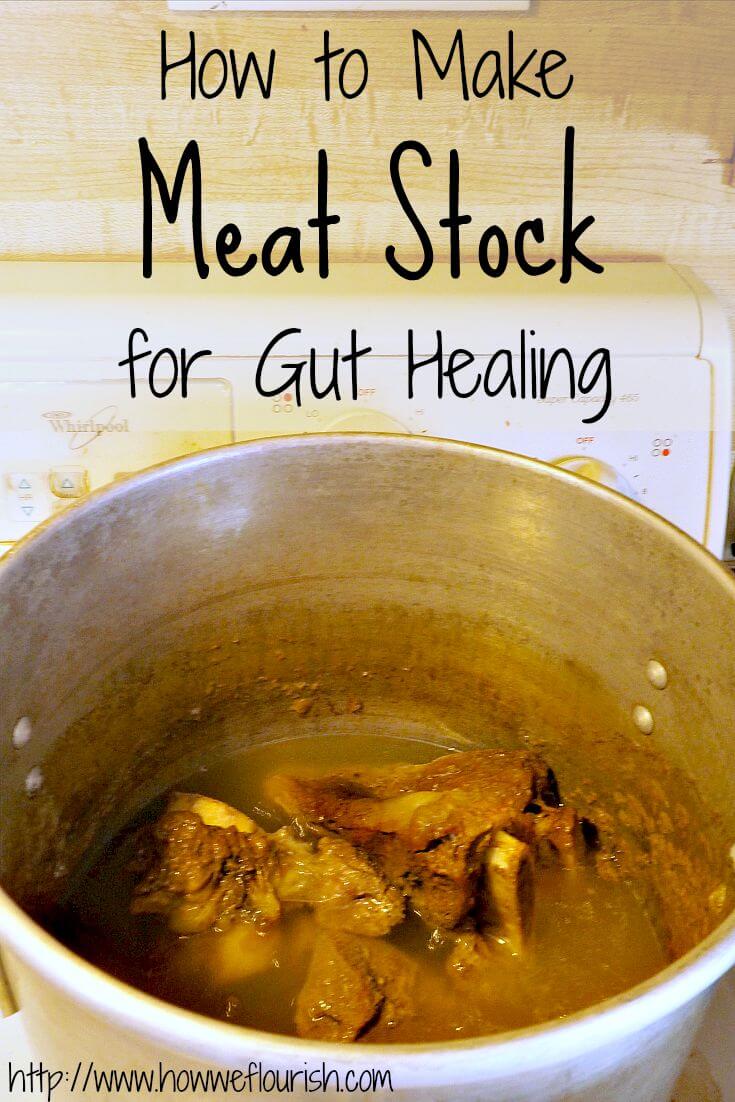I may receive a commission if you purchase something mentioned in this post. See more details here.
Last week we learned how to make bone broth. But did you know that while on GAPS Intro, you should actually be making meat stock? Read on to learn the different and how to make meat stock for GAPS.
Now, before any of you chefs get all over me for terminology, I’m fully aware that the real food community has kinda gotten these two things backwards. See, in the culinary world, broth is made from meat and stock is made from bones. In the healing diet world, it’s the opposite! So please forgive me as I talk about these two things using the terminology that is used throughout the GAPS and paleo worlds.
One of the biggest things that people do not realize about GAPS Intro is that there is no bone broth involved! If you are considering Intro, you probably know all about bone broth, its healing powers, and how everyone that needs to heal their gut is drinking it. As I discussed last week, it really is great stuff. Dr. Natasha recommends both bone broth and meat stock for people who are healing, as they have very different nutrient profiles.

However, meat stock is considered much more gentle on the gut. The connective tissues and marrow that comes from the bone-on meat used to make this stock is also incredibly healing and an essential part of the GAPS Intro protocol. Bone broth is a fantastic addition to the diet, and I consume it every day. But some people are sensitive to it, or it can be too strongly detoxifying. It is best to stick to just meat stock at the beginning.
Learn more about meat stock here (under the “First Stage” heading).
How to Make Meat Stock
Meat stock is made by taking meat on the bone (such as a whole chicken or a package of beef soup bones) and boiling it in filtered water for a short period of time, just until the meat is cooked. For chicken, this will be about an hour to an hour and a half. I always cook the giblets and a couple chicken feet with the whole chicken for extra nourishment. Beef takes about 3 hours. Even with the short cooking time, I find that my meat stock always gels very nicely. I love seeing that healing jiggle!

Once you have made your stock, you can use it however you like. Take the meat, add some vegetables, and make it into soup, as I do with my many GAPS Intro recipes. Or eat the meat separately and either drink the broth on the side, or use it to make a vegetable puree soup. I have recipes for these in Healing Patiently.
However you make your broth, what is important is that you are drinking it! Whether in a soup, used to cook up vegetables or legumes, or drunk straight out of a mug, broth and stock are essential additions to your healing diet.
This nourishing broth is an essential part of the GAPS Intro protocol. It will help heal and seal the gut, and it tastes delicious, too!
Ingredients
- Meat on the bone: A whole chicken with giblets, beef soup bones, joints, marrow bones, etc.
- Filtered water
Instructions
- Place the meaty bones in a large stock pot and cover with filtered water.
- Bring to a boil, cover, and reduce to a simmer.
- Cook until the meat is cooked all the way through, up to 3 hours.
- Strain the meat and bones out to yield a delicious and nourishing broth.
- Reserve meat, skin, connective tissues, and marrow to be consumed. Any soft parts that you do not want to consume can be blended up with some broth and added back into soups as a way to hide them.
- Store in glass in the refrigerator for up to 7 days or freeze for several months.
Shared on AIP Recipe Roundtable.
Like what you see? Please support this blog and help me keep it running by signing up for my newsletter, purchasing products, or donating through the links below:
DISCLOSURE: In order for me to support my blogging activities, I may receive monetary compensation or other types of remuneration for my endorsement, recommendation, testimonial and/or link to any products or services from this blog. The information contained in this post is not intended nor implied to be a substitute for professional medical advice, it is provided for educational purposes only. You assume full responsibility for how you choose to use this information. For more information, click here.



I’m assuming your using raw meat in water? Can I put a whole raw chicken in water and cook? And I put just enough water to cover? Do i add water while simmering? cause I know the level will go down, is that ok? New to this sorry
Yes, raw meat, and add enough water to cover. When I make chicken broth, I just put the whole raw chicken in. I do not add water while simmering unless it gets more than an inch or so below the meat.
do you put any herbs or spices, seasonings or vegetables in the pot with the meat to make meat stock
Not to make just meat stock. I add in herbs and vegetables when I make a soup with the stock.
Thank you.
This was perfect, thank you!
Thank you!
Hi..I have severe histamine last cell activation. I’m so confused and discouraged. I read how healthy and healing bone broth can be but that it’s high in histamine. Feel like I can’t win. Do you think the meat broth would help and about how many pounds if beef do you use? Thank you
Meat stock should be much lower in histamine. It is very gentle and hopefully will help. The number of pounds I use varies based on how much I have – a few pounds of soup bones covered in water will give a good start.
the ratio is for every gallon of water, you will use 5-7 lbs of bones.
I find it difficult to tolerate chicken or beef, even as a broth/stock. Would I be able to substitute and make this with a whole turkey instead?
Absolutely!
Hi Jerri-Lynn,
My name is Judith. I saw your comment and would just like to offer a suggestion in hopes that it will help in some way. I too have had serious concerns with high levels of histamine and all of the obstacles that entails this affliction. But, since I have seen a Functional Medicine doctor and he put me on a supplement that helps the body with the Dopamine level, I have gradually been able to better tolerate foods with varying histamine levels. Maybe if you ask your health care provider about testing you to see if your Dopamine level is at a normal level or do you need a supplement to help you produce more Dopamine in your body would be beneficial to you.
I hope this will help in some way,
Judith
I’m wondering if it is okay to roast the bones after blanching on GAPS? Traditionally this is how I’ve been taught to make bone broth/stock, but have not come across this method anywhere in the GAPS literature. Would appreciate your opinion!
Ana
This isn’t something I’ve ever done. I wouldn’t do it on the very early stages of Intro, but it would be fine later on!
How does Bone Broth make Histamines?
Is there a taste difference between bone broth and meat stock?
Will meat stock still “heal the gut” and other same benefits of bone broth long term? Would you recommend replacing bone broth with meat stock long term?
Thanks.
Chloe, you are really not using much meat stock with you meat. It is just boiled out. I think I was using too much water now. Thanks.
Hello, Chloe. I need to make meat stock for my daughter with special needs and Graves disease. Can I make it with just the bones -because the meat turns out flavorless, dry-, simmering it only up to 3 hours?
Can you make the meat stock in a crock pot?
Because the benefit of meat stock over bone broth is the short cooking time, it is best if it is made on the stove.